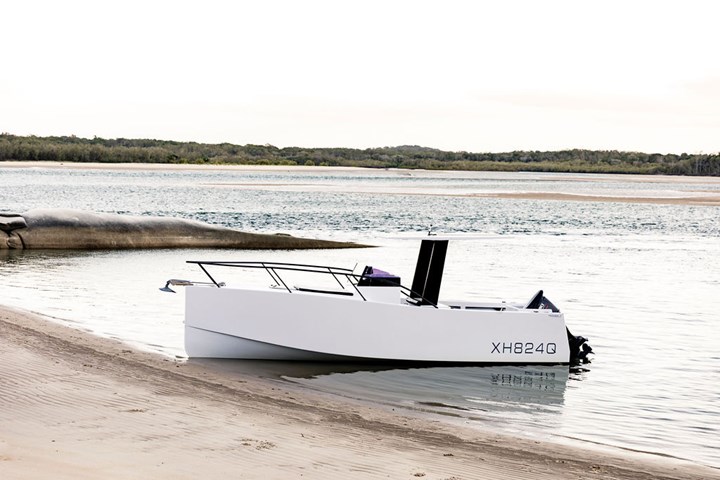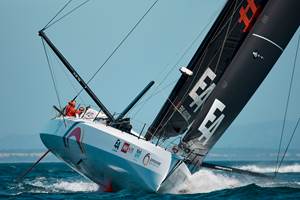ATL Composite panel systems enable Noosa 7 dynamic dayboat design
The Noosa 7 is hand-built and customized using DuraKore and DuFlex composite panel systems, minimizing material waste, tooling costs and simplifying quotations.

All photo credit: Noosa Marine
The team at Noosa Marine (Noosa, Australia) has announced that it is crafting the Noosa 7, a seven-meter motor yacht designed by Director Julian Griffiths and said to be only the second unit ever built. The dayboat is constructed using DuraKore and DuFlex panel systems from ATL Composites (Molendinar, Australia) and at 2.3 meters wide x 7.3 meter long, weighs only 1,250 kilograms.
With space for up to eight people, sleeping four in comfort, the Noosa 7 boasts a deck shower and fridge under the helm, and a 140-horsepower Suzuki engine. It is also lightweight enough that it can be transported via trailer.
Noosa Marine’s Julian Griffiths is said to be renowned for his expertise in building multihulls for marine craft using these composite panel systems, including the Schionning G Force 2000 Special (“KATO”) catamaran, as well as the Roger Hill-designed 14-meter AYANA and 19.5-meter BAJACA. Noosa Marine says Griffiths is now focused on promoting his own designs under the Noosa brand.
The Noosa 7 was one such design, and was first built ten years ago. “It was ahead of the times,” Griffith says. The craft is said to be compact, light weight, serves well as a day boat or weekender and is sturdy and stable enough for runs up to Double Island Point and Musgrave Island from Noosa at a top speed of 30 knots. “I built the first one for myself, without plans, just making it up as we went along. For this second one, we’re making plans as we go. A draughtsman is measuring and doing the drawings which will be computerized. Then we’ll get a kit produced from ATL so future boats are a quicker build for us.”
The first Noosa 7 was constructed using DuraKore Strip Planking for the hull, but Griffith says the following models will be made of 100% DuFLEX Composite Panels in CNC-routed kit form. The kit technology minimizes material waste, tooling costs and simplifies quotations.
“DuFLEX is brilliant to work with,” says Griffith. “You can create boats that are quicker, lighter and stronger. Our boats aren’t molded. Instead, they are made by hand, using widely spaced temporary build frames that are CNC- routed from design files to the required shape. Large parts like hull panels are created by bending the flat panels around the frames, ensuring a fair hull shape.”

Build time is approximately four months and the cost of the Noosa 7 with engine and nav gear is approximately $140,000. “This is a hand-built, high-end, epoxy composite product. Unique and one-off, you are buying a custom vessel. It’s not for everybody, but we are hopeful of catering to a niche of coastal cruisers looking for something different,” says Griffith. He adds that Noosa Marine is aiming to build around five to eight per year, depending on labor.
“There’s also a 10-meter version in the works, just waiting for somebody to spot it and make it their own,” he says. The larger model will be priced around $300,000. “It’s more like a super tender, European style with a V8 diesel inboard and the works onboard.”
Owners will also be provided after-sales support. “It’s my name, my pride that go into our boats,” asserts Griffith. “Once you buy one of our boats, you’re in the family.”
Related Content
European boatbuilders lead quest to build recyclable composite boats
Marine industry constituents are looking to take composite use one step further with the production of tough and recyclable recreational boats. Some are using new infusible thermoplastic resins.
Read MoreRefurbished Einstein yacht demonstrates innovative composites repair and redesign
Years of creative engineering work went into resurrecting the composites-intensive IMOCA 60 racing yacht — with award-winning results.
Read MoreAl Seer Marine, Abu Dhabi Maritime unveil world’s largest 3D-printed boat
Holding the new Guinness World Record at 11.98 meters, the 3D-printed composite water taxi used a CEAD Flexbot to print two hulls in less than 12 days.
Read MoreAlliance for European Flax-Linen and Hemp reports increasing flax fiber adoption in marine
The natural fiber is increasing traction across several marine applications, including in projects by Greenboats, Northern Light Composites, the Beneteau Group and others.
Read MoreRead Next
All-recycled, needle-punched nonwoven CFRP slashes carbon footprint of Formula 2 seat
Dallara and Tenowo collaborate to produce a race-ready Formula 2 seat using recycled carbon fiber, reducing CO2 emissions by 97.5% compared to virgin materials.
Read MoreVIDEO: High-volume processing for fiberglass components
Cannon Ergos, a company specializing in high-ton presses and equipment for composites fabrication and plastics processing, displayed automotive and industrial components at CAMX 2024.
Read More“Structured air” TPS safeguards composite structures
Powered by an 85% air/15% pure polyimide aerogel, Blueshift’s novel material system protects structures during transient thermal events from -200°C to beyond 2400°C for rockets, battery boxes and more.
Read More
























